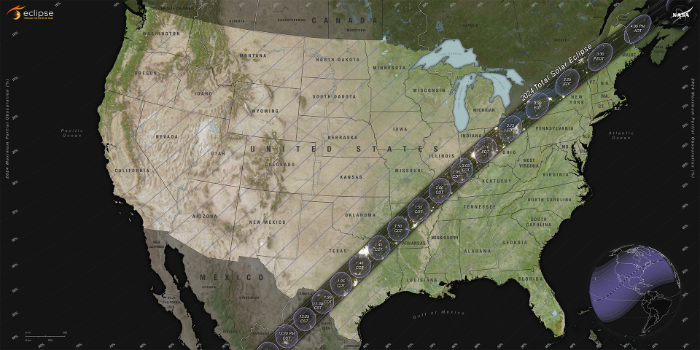Blog | April 04, 2024
Blog: Beneath the shadow: Texas counties prepare for solar eclipse

For months – years even – Texas county officials have been preparing for the total solar eclipse on April 8. The event is expected to draw more than a million visitors along the eclipse's 115-mile-wide path of totality. In Texas, the center of the path of totality will stretch from Maverick County on the U.S.-Mexico border to Red River County on the border with Oklahoma.
The latest episode of the Texas Association of Counties' podcast, Texas County Voice, weaves together interviews with county officials in Bandera, Llano and Rains counties to illustrate the plans that counties have implemented to ensure the safety and enjoyment of residents and visitors alike. Drawing on lessons learned from the 2017 total solar eclipse that crossed the United States from the northwest to the outheast, county officials have consulted with one another and coordinated preparations with state agencies for what will be a once-in-a-lifetime event for many Texans.
In Bandera County, Commissioner Jack Moseley recalls first hearing about the eclipse a quarter-century ago. With his encouragement, the county held its first eclipse-planning meeting three years ago. Bandera County anticipates 80,000 to 100,000 visitors – about four times its resident population. Eclipse plans include deploying deputies for traffic management, ensuring emergency communication methods and setting up strategic supply points.
"It's coming," Moseley said of the eclipse. "We can't stop it. And we're prepared. We're as prepared as we're going to get."
About 90 miles northeast in Llano County, Judge Ron Cunningham emphasizes the power of regional collaboration. The county is expecting 30,000 to 40,000 people. Maybe more, maybe less. No one really knows, Cunningham said, which adds to the challenge of preparing for the eclipse. Llano County has stocked up on essentials such as fuel for its law enforcement vehicles and ambulances and made other arrangements to accommodate the surge in numbers.
"What we're explaining to everyone involved is the eclipse in itself is not a disaster. There are situations that could occur during the eclipse that could flip it to a disaster in just a matter of minutes. And that's what we have to be prepared for," Cunningham said.

The eclipse will be viewable in Texas between 1:30 p.m. and 1:45 p.m. on April 8. (Credit: NASA)
In Northeast Texas, Rains County Judge Linda Wallace and Emergency Management Coordinator Joe Parker discuss their recently initiated preparations for a potential influx of up to 60,000 visitors, five times the county's modest population of 12,000. Despite concerns about traffic and strained resources, Wallace and Parker are hopeful the county will experience a safe and memorable event under the shadow of the moon.
"I'm excited about the event itself. We just want to make sure it's a good event and not a bad day for Rains County," Wallace said.
With the eclipse now just days away, the weather is adding an extra layer of complexity to the preparations. The forecast for good viewing conditions April 8 is looking ... iffy, let's say, up and down the Texas path of totality.
Yet, one thing is certain. Texas counties are poised to ensure a safe and memorable experience for all who come to witness this spectacular event.

